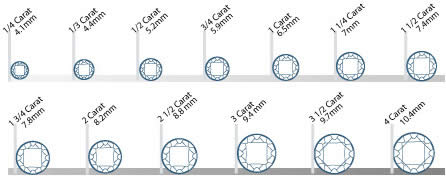In ancient times gem traders would use a method of weight based on the carob seed. This seed from the locust tree is very consistent in its weight and made an ideal basis of measurement. A 1 carat diamond equaled one carob seed but today this translates to 200 milligrams or 1/5th of a gram. Diamond weights today are expressed in carats or “points”. For example, a 1 carat diamond equals 100 points. A 0.50 carat diamond equals 1/2 carat or 50 points, and a stone that weighs 150 points is a 1 1/2 carat diamond.
Most people believe that the bigger the diamond the better. However, as explained in the section on cut, a diamond that weighs more is not always larger in circumference. Therefore, you should be careful in selecting diamonds solely based on the weight of the diamond.
A diamonds value will grow dramatically if it crosses the threshold from say 0.99 carats to 1.00 carats. Though only .01 points separate the two diamonds, the 1 carat stone will be worth significantly more money. It doesn’t take most people long to see the possible advantage in “buying shy”. That is, buying slightly below the threshold to get a stone that is almost as large and save money. This theory does have some issues depending on the type of stone, weight, and worldwide supply. Sometimes a 1 carat diamond will be marginally more, maybe a couple of hundred dollars but will be worth much more as time goes by.

14 Karat recommendation on CARAT WEIGHT
When considering diamond size, it is important to balance it with the other factors such as color, clarity and cut. Bigger is not always better and in many cases those who live by that mantra are often disappointed with their choice in a fine diamond. Better advice is to investigate what the average selling price of a certain size of stone is and then determine if the colors and clarities in that average are acceptable to you.
 14 Karat
14 Karat